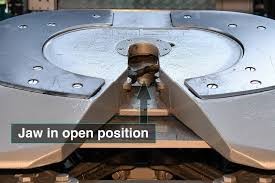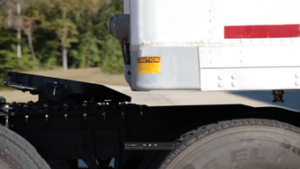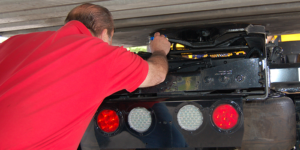Where Should the Tractor Be When You Inspect the Landing Gear After Uncoupling the Trailer?
 Once everything passes inspection, you can back up to the trailer to couple. Make sure that you back up slowly and straight to the trailer. Never back up to a trailer at an angle, as you can push the trailer sideways and damage the landing gear. Backing up to a trailer at an angle will almost certainly break the cab extenders on your tractor.
Once everything passes inspection, you can back up to the trailer to couple. Make sure that you back up slowly and straight to the trailer. Never back up to a trailer at an angle, as you can push the trailer sideways and damage the landing gear. Backing up to a trailer at an angle will almost certainly break the cab extenders on your tractor.
As you back up to the trailer, do so with caution. If you back up too fast you can cause serious damage to the trailer and the truck. Approach slowly, and then stop before making contact with the trailer. Apply the parking brake and make sure you are in neutral. One of the most common mistakes is trying to couple at the wrong kingpin height. Trying to couple at an improper kingpin height can result in Fifth Wheel damage and/or truck and trailer damage. If the trailer is too high it will not strike the trigger and could miss the Fifth Wheel all together, hitting the truck against the trailer. If the trailer is too low you can easily damage the Fifth Wheel and the trailer. At the proper coupling height, the upper portion of the Fifth Wheel approach ramp strikes the leading edge of the trailer.

Correct Kingpin Height
To adjust your trailer height, use the crank handle to raise or lower the landing gear of the trailer. Once you are aligned, you can use the lowest gear and back up slowly to your trailer. The trailer will lift slightly and you will hear the kingpin locking into the Fifth Wheel.
Avoid hitting the Kingpin too hard. Despite what you may think, it only requires 30 pounds of pressure to trigger the kingpin lock and couple to the trailer. After you are coupled to your trailer, connect the electrical lines and air lines from the truck to the trailer.
Make sure the lines are secure and not dragging or tangled. Raise the landing gear slightly off the ground to perform the "tug test". While the trailer brakes are still engaged, put the tractor in gear and ease forward just enough to feel the resistance of the load. If the coupling feels secure, place the transmission in neutral, engage the parking brake, and shut off the engine.

Inspecting Jaws and Kingpin connection once coupled
After coupling, you must get out of the cab and perform a visual inspection before moving the tractor and trailer. Visually inspect to make sure the pull handle is retracted, there is no gap between the Fifth Wheel and trailer, and the kingpin is secured by the jaw and wedge. Using a flashlight will help you get a better visual that the kingpin is secured. Once all steps are followed you are good to roll with your load.
Before uncoupling, make sure that you align the tractor and trailer. Ensure that the truck and trailer are parked on a flat, level surface that can support the trailer and its loaded weight. Also make sure the air ride suspension is inflated. Make sure that the air bags are never deflated when trying to uncouple from the trailer as this will make the Fifth Wheel very difficult to open and could actually damage the Fifth Wheel and king pin.
Lock the trailer brakes and back up slightly and slowly to ease pressure on the Fifth Wheel locking jaw. Now engage the parking brake while the tractor is pushing against the kingpin, this will help you release the Fifth Wheel locking lever. Now you can lower the landing legs. Since our tractors are equipped with air suspension you should lower the landing legs until they touch the ground and then add one additional turn. Disconnect the air lines and electrical lines and secure them to the tractor.
For manual Fifth Wheels, pull the release handle straight out and up until the locking mechanism is secured in the open position. If your truck is equipped with the air release system you will need to visually inspect that the jaws are all the way opened. If they are not, then you will need to pull the manual handle to release the jaws all the way. Now ease the tractor forward until the Fifth Wheel comes out from under the trailer, let the trailer slowly slide down the Fifth Wheel approach ramps. Stop with the tractor frame still under the trailer – this prevents the trailer from falling if the landing gear fails or sinks into the ground. Engage the parking brake and go out and inspect that the landing gear is supporting the trailer properly. Once everything checks out, you can then release the parking brake and slowly pull out from under the trailer.
Following the proper steps and procedures to coupling and uncoupling a trailer is very important and helps keep you and all your co-workers out on the road with less down time due to Fifth Wheel, truck, or trailer damages. If at any time you have any questions or concerns about this topic, or any other maintenance concerns, please feel free to reach out to our team here at your maintenance facility.
Where Should the Tractor Be When You Inspect the Landing Gear After Uncoupling the Trailer?
Source: https://www.ltitrucking.com/how-to-couple-to-a-trailer/
0 Response to "Where Should the Tractor Be When You Inspect the Landing Gear After Uncoupling the Trailer?"
ارسال یک نظر